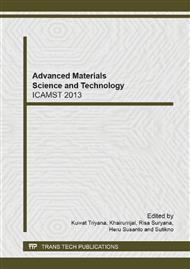p.145
p.149
p.153
p.159
p.163
p.168
p.175
p.179
p.183
Characteristics of Water-ZrO2 Nanofluids with Different pH Utilizing Local ZrO2 Nanoparticle Prepared by Precipitation Method
Abstract:
Changing water as the conventional nuclear reactor coolant with nanofluid in order to increase the efficiency of heat transfer in the nuclear reactors becomes a strong need. In this work, a study of synthesis and characterization of ZrO2 nanoparticle and water-ZrO2 nanofluid was done. The ZrO2 nanopowder was synthesized using a precipitation method from ZrOCl2.8H2O (ZOC) that was prepared from local zircon (ZrSiO4) using caustic fusion method with calcination temperature of 800°C. The ZrO2 nanoparticle contained two phases namely cubic and monoclinic with crystallite size of 12 nm measured using Debye Scherrer method. Stability of nanofluids that prepared by mixing the ZrO2 nanoparticle with water depended on pH. The nanofluids with pH less than 5 and larger than 8 were stable. Sedimentation test showed that the Water-ZrO2 nanofluid produced in this study was very stable until at least 9 days. A typical basic nanofluid has zeta potential of about-41 mV and a typical acidic one has zeta potential of +45 mV. Thermal conductivity of the nanofluids was 4-9 % larger than that of water.
Info:
Periodical:
Pages:
163-167
Citation:
Online since:
February 2014
Authors:
Keywords:
Price:
Сopyright:
© 2014 Trans Tech Publications Ltd. All Rights Reserved
Share:
Citation:


